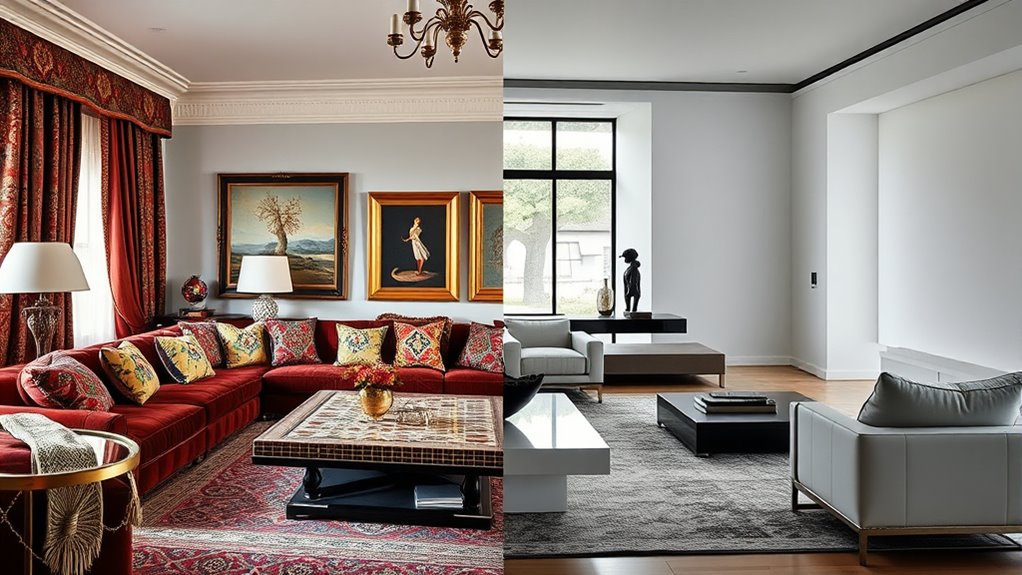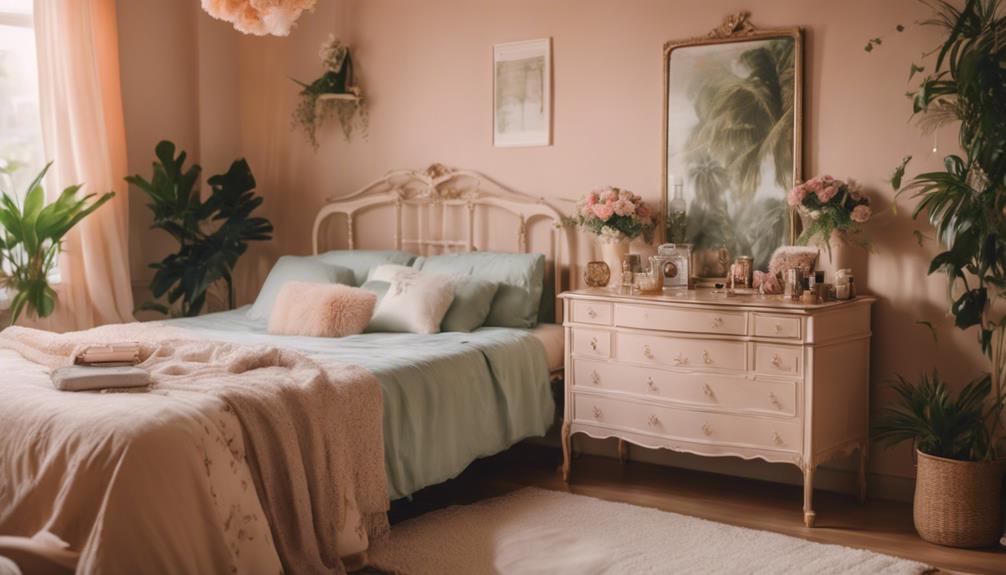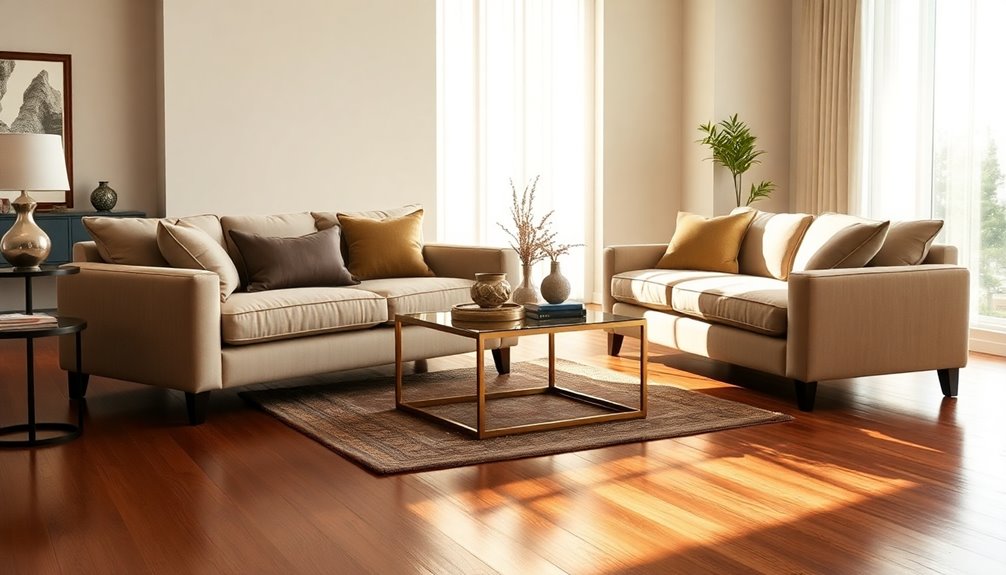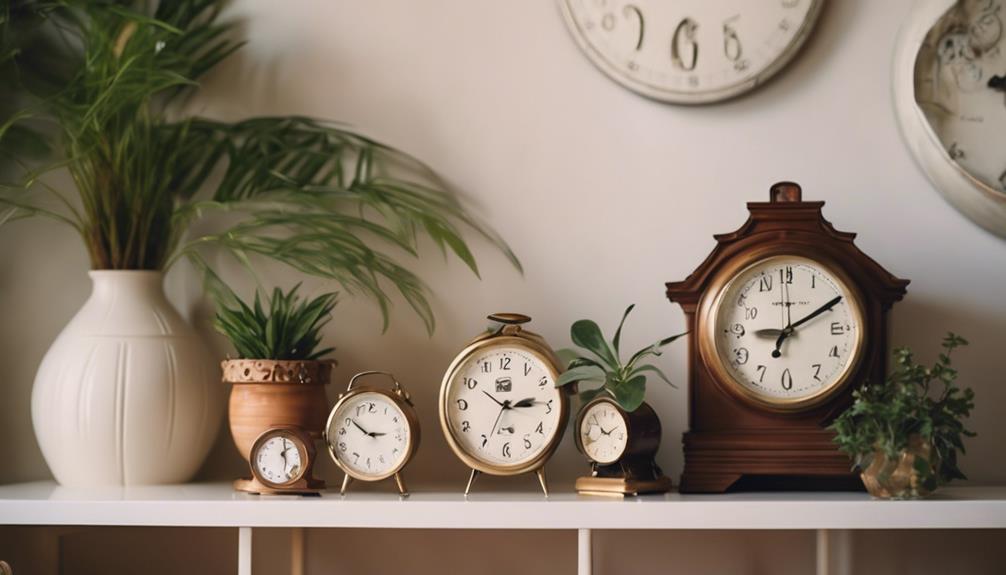Maximalism and minimalism in interior design reflect different personalities. Maximalism embraces bold colors, layered textures, and decorative details for a lively, expressive space. Minimalism favors clean lines, neutral palettes, and open spaces for a calm, uncluttered environment. Your lifestyle, preferences, and feelings about color and texture help determine which style suits you best. Keep exploring to discover how to blend these styles or choose the one that truly matches your personality.
Key Takeaways
- Understand the core aesthetic differences: maximalism is bold and layered, minimalism emphasizes simplicity and clean lines.
- Reflect on your personality and lifestyle to choose a style that authentically represents your identity.
- Consider color and material preferences: vibrant and textured for maximalism, neutral and sleek for minimalism.
- Mix and match elements carefully to blend styles for a personalized, balanced interior.
- Identify the mood you want to evoke: lively and expressive or calm and uncluttered.
Defining Maximalism and Minimalism in Interior Design
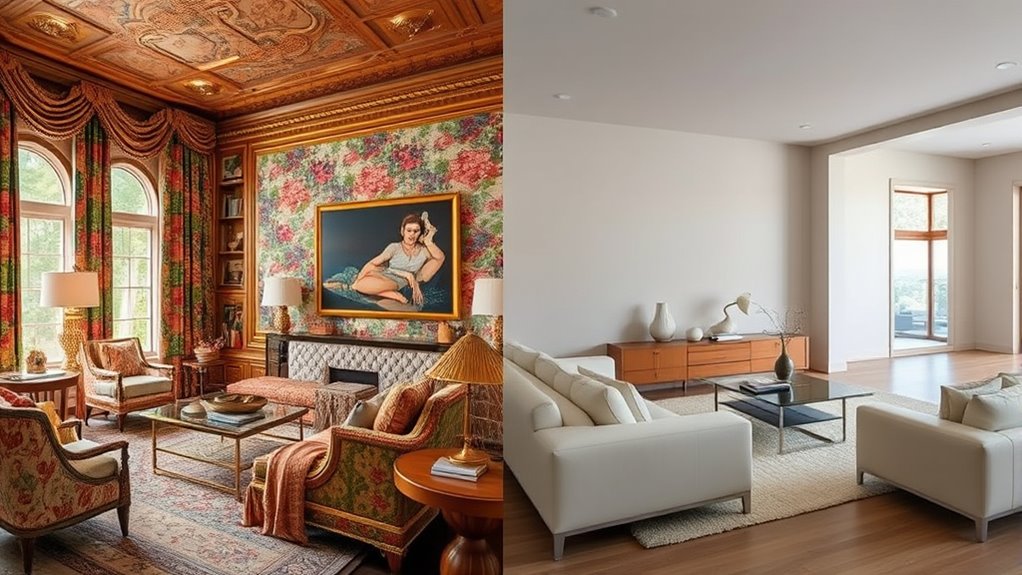
While both maximalism and minimalism shape interior design, they represent opposite approaches to space and decoration. Maximalism embraces boldness, filling rooms with decorative accessories, vibrant colors, and layered textures. It encourages you to express your personality through eclectic arrangements and eye-catching lighting fixtures that add drama and warmth. In contrast, minimalism focuses on simplicity, emphasizing clean lines and open space. It favors a pared-down selection of decorative accessories, often choosing sleek lighting fixtures that blend seamlessly into the environment. Maximalist spaces feel lively and dynamic, while minimalist interiors evoke calm and clarity. Understanding these core differences helps you identify which style aligns with your taste, setting the foundation for creating a space that truly reflects your personality.
Key Characteristics and Aesthetic Principles of Each Style
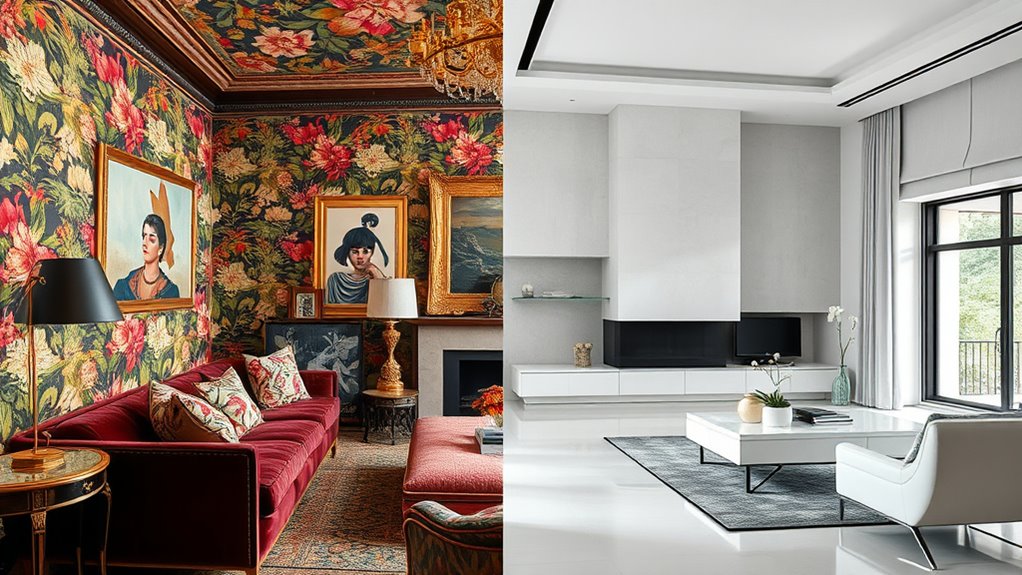
Maximalism and minimalism each have distinctive characteristics that define their unique aesthetic principles. In maximalism, you’ll find a celebration of bold colors, layered textures, and abundant decorative accessories that create a vibrant, curated look. Architectural details are often elaborate, adding depth and personality to the space. In contrast, minimalism emphasizes simplicity, clean lines, and a restrained color palette, where less is more. To distinguish each style:
- Maximalism features rich patterns, diverse decorative accessories, and ornate architectural details.
- Minimalism highlights open space, sleek furniture, and subtle architectural features.
- Both styles use these elements intentionally to evoke different moods—dynamic and expressive for maximalism, calm and uncluttered for minimalism.
- Understanding the design elements involved in each approach helps you craft a space that aligns with your personal aesthetic.
The Impact of Personal Lifestyle and Preferences

Your lifestyle influences your interior design choices more than you might realize. Preferences reflect your personality and daily routines, shaping the overall look and feel of your space. When you design with your identity in mind, your home becomes a true reflection of who you are. Recognizing personalized behaviors can help you create a space that truly supports your emotional well-being and daily needs. Incorporating elements that align with your seasonal preferences ensures your environment remains comfortable and inspiring throughout the year. Being aware of cultural influences can also enrich your design choices, making your space uniquely yours.
Lifestyle Shapes Aesthetics
Personal lifestyle choices and daily habits directly influence the aesthetics of your living space, shaping the design elements you prefer. Your cultural influences and historical inspirations play a pivotal role in this process. For example:
- If you value tradition, you might incorporate vintage furniture and classic motifs that reflect your heritage.
- A love for travel could lead you to include artifacts and textiles inspired by different cultures.
- An appreciation for history might inspire you to blend antique pieces with modern design, creating a layered, meaningful environment.
- Engaging in creative practice can also influence your interior style by inspiring unique and personalized decor choices, fostering a space that truly reflects your individuality.
These elements help create a space that mirrors your identity and experiences. Your lifestyle, rooted in personal history and cultural background, guides your aesthetic choices, making your home a true reflection of who you are.
Preferences Drive Choices
Have you ever noticed how your daily routines and personal tastes shape the way your home looks? Your preferences are influenced by cultural influences and historical context, guiding choices in furniture, colors, and decor. For instance, someone from a Mediterranean background might favor vibrant colors and ornate patterns, reflecting their heritage. Conversely, a person influenced by minimalism’s history may prefer clean lines and simplicity. Understanding this connection helps you craft a space that resonates with your identity. Consider how these influences shape your preferences: Self Watering Plant Pots can also reflect your personal style by combining functionality with aesthetic appeal. Recognizing the role of personal preferences allows you to create a space that truly feels like home.
Personal Identity Reflected
Ever wonder how your lifestyle and daily habits shape the look of your home? Your personal identity, influenced by cultural influences and historical context, is reflected in your space. To express this, consider these aspects:
- Incorporate cultural artifacts or motifs that resonate with your background or travels.
- Choose furniture and decor that echo your historical influences, like vintage pieces or modern reinterpretations.
- Use colors and patterns that mirror your personal taste and cultural roots.
Your choices reveal more than aesthetics; they tell your story. Whether embracing minimalism for clarity or maximalism for vibrancy, your home becomes a reflection of who you are. By understanding these influences, you create a space that truly embodies your unique identity.
Color Palettes and Material Choices in Each Approach
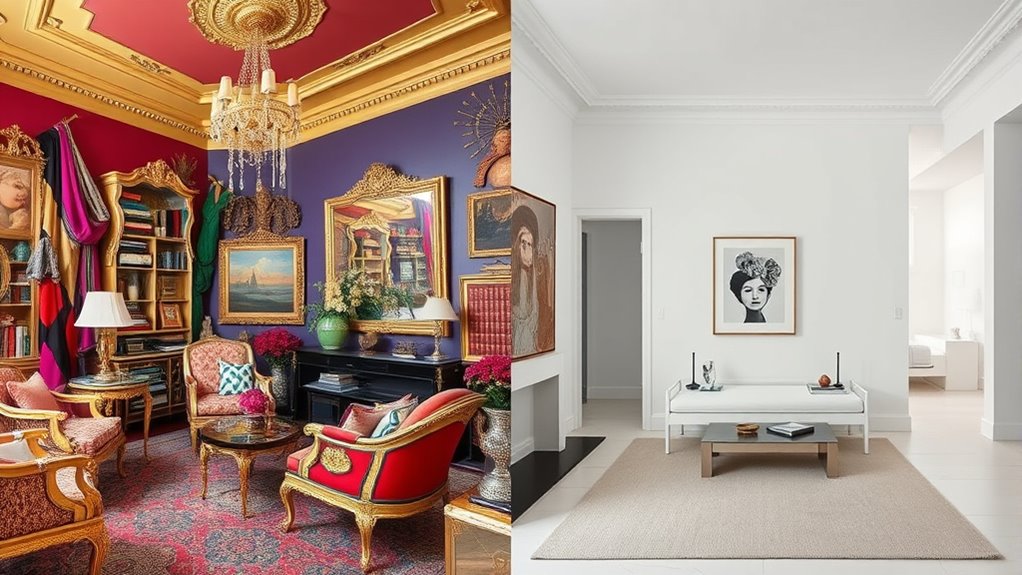
Different interior design styles rely on distinct color palettes and material choices that define their character. In minimalism, you’ll find a focus on neutral tones like whites, grays, and beiges, emphasizing color harmony through simplicity. Materials are often sleek and smooth—think glass, polished metals, and light woods—that create a clean, uncluttered look. Maximalism, on the other hand, embraces bold, vibrant colors like jewel tones and rich patterns. Material textures play a crucial role here, with layered fabrics, ornate woods, and mixed metals adding depth and visual interest. These choices help evoke emotion and personality, whether you prefer the calm serenity of minimalism or the energetic richness of maximalism. Your goal is to use color and texture to reinforce the style’s core identity.
How to Incorporate Elements of Both Styles for a Unique Space

Blending elements of minimalism and maximalism creates a dynamic and personalized space that reflects your unique style. To achieve this, focus on balancing decorative accents with space optimization. First, choose a neutral or simple base to keep the room feeling open and uncluttered. Then, add bold, colorful decorative accents—like artwork or textiles—that showcase your personality. Incorporating visual interest through layered textures and patterns can be achieved without overwhelming the space. Keep clutter at bay by prioritizing function and strategic placement. This way, you maintain a sense of order while embracing the richness of maximalist decor. The key is to blend carefully selected accents with streamlined elements, creating a harmonious space that’s both lively and serene. Incorporating storage solutions can also help manage the additional decor without sacrificing organization. Sustainable design principles can also guide you in selecting eco-friendly materials and reducing waste, ensuring your space is stylish and environmentally conscious.
Pros and Cons of Embracing Maximalism and Minimalism
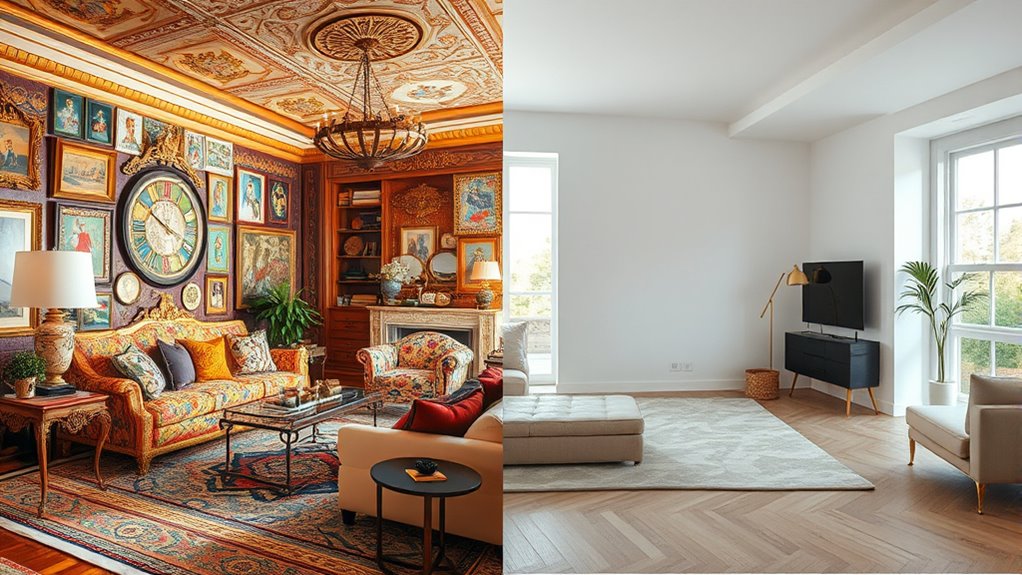
Maximalism offers vibrant layered visuals that showcase your personality, but it can feel overwhelming or cluttered. Minimalism emphasizes clean lines and simplicity, creating a calm space, yet it might seem too sparse or impersonal. Consider how personal expression and flexibility influence your choice between these styles. Practicing mindfulness and presence can help you better understand which design approach aligns with your inner sense of peace and well-being. Additionally, understanding the contrast ratio and how it impacts visual clarity can inform your preferences for a dynamic or subdued aesthetic. Exploring hackathons, such as virtual or internal company events, can also inspire creative ways to experiment with design concepts in collaborative environments.
Layered Visuals Versus Clean Lines
Choosing between layered visuals and clean lines fundamentally shapes the atmosphere of your space. Layered visuals create richness through texture contrast and dynamic spatial organization, making your room feel inviting and vibrant. Conversely, clean lines emphasize simplicity, offering a sense of calm and order. Consider these factors:
- Texture contrast: Maximalism thrives on varied textures, adding depth and visual interest.
- Spatial organization: Minimalist designs rely on open, uncluttered arrangements that highlight each element. Additionally, minimalist spaces often utilize negative space to enhance the feeling of openness.
- Atmosphere: Layered visuals generate warmth and personality, while clean lines foster serenity and minimal distraction.
- Cultural influences, like Zodiac Sign Compatibility, can also inspire your interior style choices to reflect your personality and relationships.
Your choice impacts how you experience your space daily. Layered visuals might feel lively but busy, whereas clean lines promote clarity. Weigh these pros and cons to find the style that best suits your lifestyle and personality.
Personal Expression and Flexibility
While both maximalism and minimalism offer distinct ways to express your personality through interior design, each approach comes with its own set of advantages and limitations. Maximalism encourages personal expression through bold colors, diverse textures, and cultural influences, creating spaces rich with history and meaning. However, it can feel overwhelming or cluttered if not carefully curated. The principles of the refrigeration cycle can also inspire innovative approaches to space efficiency and environmental sustainability in interior design. Additionally, understanding support hours and scheduling considerations can help plan renovations or redesign projects around seasonal and operational schedules. Incorporating space optimization strategies can further enhance the functionality and aesthetic of a maximalist space. Ultimately, choosing between the two depends on whether you value showcasing your personality through layered details or prefer a versatile, understated environment.
Tips for Transitioning Between Styles or Combining Them Effectively
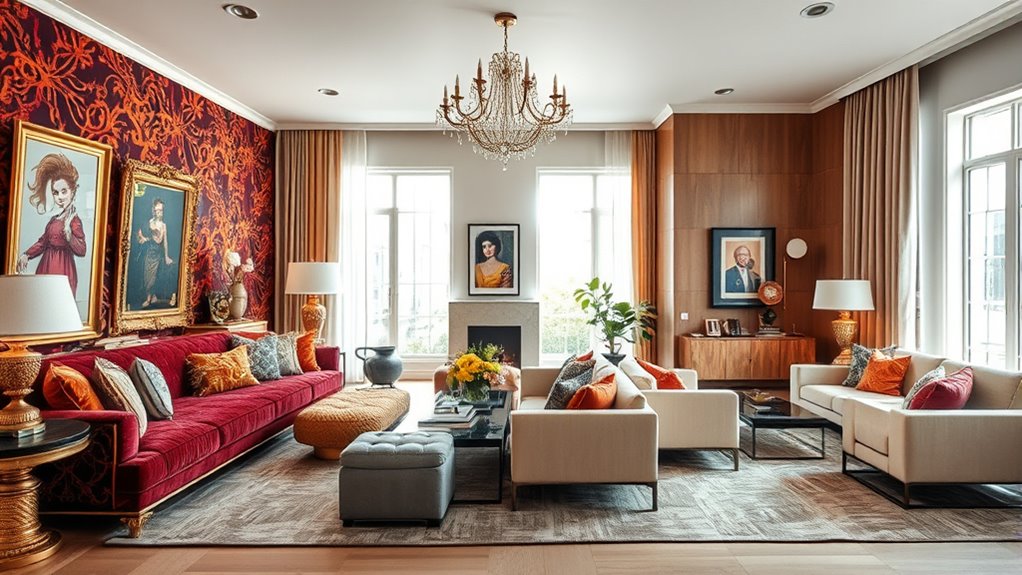
Shifting between interior design styles or blending them seamlessly requires a thoughtful approach to balance and harmony. To overcome decorating challenges and stay within budget considerations, start by defining a unifying element, like a neutral palette or consistent hardware. Next, consider these tips:
Balancing diverse styles requires a unifying element and thoughtful mixing for harmony.
- Use accessories to introduce new styles without significant costs or overwhelming the space.
- Mix textures and patterns carefully to create visual interest while maintaining cohesion.
- Gradually incorporate statement pieces from different styles to avoid clutter and maintain flow.
- Understanding design terminology can help you communicate your vision clearly and select complementary elements effectively.
- Incorporating positive thinking principles can help you stay motivated and open-minded during your interior transformation journey.
- Recognizing family dynamics can also influence your style choices, especially when blending personal and cultural influences into your decor.
Frequently Asked Questions
How Can I Balance Maximalist and Minimalist Elements in One Room?
To balance maximalist and minimalist elements, you should focus on layering textures and mixing patterns thoughtfully. Start with a neutral base to keep the space feeling open, then add bold patterns and rich textures in accessories or accent pieces. Keep larger furniture simple and streamlined, allowing decorative elements to stand out. This approach creates harmony, making your room feel lively yet uncluttered, blending both styles seamlessly.
Which Style Is More Sustainable or Eco-Friendly in the Long Run?
Think of a lush forest versus a sleek, modern cityscape. Sustainability favors eco-friendly furniture and sustainable materials, making minimalism more eco-conscious in the long run. It often involves fewer resources, less waste, and a focus on durability. Maximalism might use more materials, but choosing sustainable options helps reduce environmental impact. So, if you’re aiming for longevity and eco-friendliness, minimalism’s simplicity often aligns better with sustainable practices.
How Do I Choose the Right Furniture Size for Each Style?
When choosing furniture size, focus on scale and proportion to match your space. Measure your rooms carefully and consider furniture dimensions that complement the room’s size. For a minimalistic style, opt for sleek, smaller pieces that create openness. For maximalism, select larger, statement furniture to fill the space without overwhelming it. Ensuring the furniture’s scale fits your room helps create a balanced, harmonious environment.
Are There Specific Lighting Choices That Complement Each Style?
Lighting is the brush that paints your room’s mood. For minimalism, opt for ambient lighting that’s soft and understated, like gentle whispers guiding your space. In maximalist rooms, statement fixtures act as jewelry, drawing the eye and sparking conversation. Think bold chandeliers or sculptural lamps. Choose lighting that echoes your style—subtle elegance or daring drama—so your space glows with personality and purpose.
How Do I Personalize Spaces Within Maximalist or Minimalist Frameworks?
To personalize your space, focus on artistic expression and cultural influences that resonate with you. In a minimalist setting, add meaningful artwork or unique textures to create subtle personality. For maximalist spaces, layer vibrant patterns, bold colors, and eclectic decor to showcase your individuality. By thoughtfully selecting pieces that reflect your personality and cultural background, you make your space uniquely yours, whether you prefer simplicity or abundance.
Conclusion
Ultimately, your interior style should reflect who you are. Whether you lean toward the boldness of maximalism or the simplicity of minimalism, remember that balance is key. Don’t be afraid to blend elements from both to create a space that feels truly yours. As the saying goes, “Variety is the spice of life”—so embrace your preferences and craft a home that inspires and comforts you every day.
